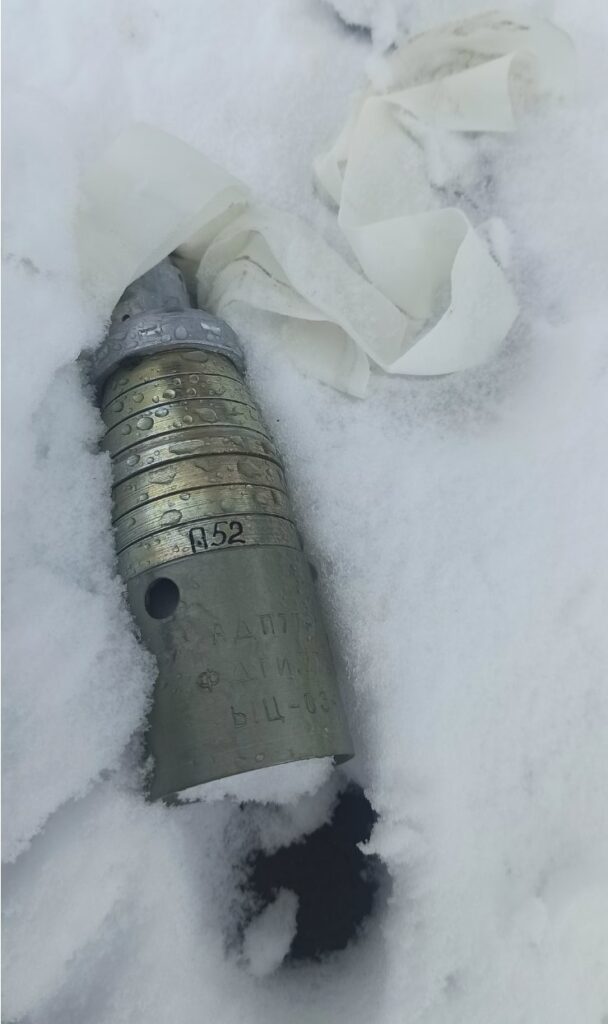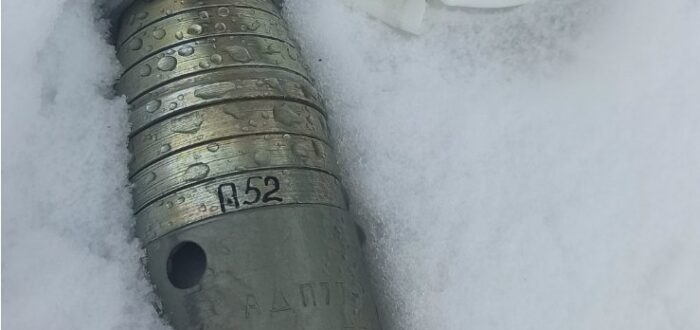N.R. Jenzen-Jones & Patrick Senft
Pictures shared to social media show a Russian 3Б30 (3B30) submunition in Ukraine, apparently photographed during the recent Russian invasion (see Figure 1). 3B30 submunitions were reportedly used to strike the village of Chornomorske, in the Kherson Oblast in southern Ukraine (not to be confused with the village of Chornomorske in Crimea). The body of the submunition is marked, amongst other things, “АДП77” (‘ADP77’). A Russian source has told ARES that the ADP77 and ADP77-1 are enhanced bodies for the 3B30 (3Б30) submunition, offering greater rolled homogeneous armour equivalent (RHAe) penetration and better behind-armour effects. Previous information available to ARES and others listed the ADP77 and 3B30 as distinct munitions, when it appears that the former is in fact a designation for a body (and warhead) component for the latter.

The 3B30 (sometimes rendered ‘3-B-30’) submunition is of the dual-purpose improved conventional munition (DPICM) type, combining anti-personnel and anti-armour effects by employing both a shaped charge (high explosive anti-tank, or HEAT, type) and fragmentation. It appears that at least one, and possibly two, later developments have modified the capabilities of the 3B30. Some munitions have been identified with the ‘ADP77’ markings indicated above, both in Syria and recently in Ukraine. There are also sources, including a Russian patent document, describing the development of an ‘ADP77-1’ variant. It is not clear whether that means there are three variants of the 3B30 (‘standard’, ADP77, and ADP77-1), or just two (i.e., if the ADP77 variant is the standard type). These submunitions are sometimes referred to using the term ‘КОБЭ’ (‘KOBE’; see Figure 2), referring to the Russian term кумулятивно-осколочный боевой элемент—essentially ‘HEAT-FRAG warhead’.

According to the Russian patent, the goal of the ADP77-1 improvement was to maintain the capability of destroying lightly armoured vehicles (armour thickness of up to 70 mm) while increasing the behind-armour effect—that is, the damage caused to the interior of the target vehicle and its crew. This was achieved by using Zirconium as the liner material and by changing the geometry to produce a less-focused plasma stream. Zirconium is a metal with physical properties similar to titanium. Zirconium was used in the ADP77-1 design due to its greater fragility (lower elastic-plastic properties) compared with steel or copper. Additionally, finely divided zirconium is pyrophoric, spontaneously igniting upon contact with the air. This increases the overall lethality of the submunition, providing an incendiary effect which can injure crew or passengers inside an armoured vehicle, or ignite secondary fires (including exposed fuels, ammunition, etc.).
According to the ADP77-1 patent, the body of the warhead is made from “20 GOST 1050-80 steel”, with an explosive charge of a composition referred to as “OMA TU 84-760-78” initiated by the plastic explosive “PT-83 AOTU 472”. In this configuration, the submunition defeated 40 mm of medium-hard armour steel from a distance of 65 mm. The shaped charge jet made an entry hole of 15 mm in diameter, and the fragments were thrown in a cone of ~ 55°. This created a density of 10–12 fragments per m3 (800–1,000 fragments per m2) with a velocity of 2.65 km/s. By way of of comparison, some sources indicate that another variant of the 3B30 submunition is reported to be capable of defeating 160mm RHAe.

Sources indicate this submunition has been loaded into both 9M218 122 mm rockets, fired from the BM-21 Grad (Град; ‘Hail’) multiple-barrel rocket launcher (MBRL), and 9M55K5 300 mm rockets, fired from the 9K58 Smerch (Смерч; ‘Tornado’) MBRL. The 300 mm 9M55K5 cargo rocket reportedly caries 588 3B30 submunitions, whereas the 122 mm 9M218 rocket carries 45 3B30 submunitions. Both MBRLs have been used in the attacks on Ukraine in recent days. It appears the 3B30 may also be carried by the 9M544 guided cargo missile. Sources also told ARES there has been discussion regarding an air-delivered variant, however this has not been confirmed in the literature or in combat use. The 3B30 has also been documented in Syria, and is described in a forthcoming ARES report examining the wide range of submunitions employed in the Syrian conflict. Information on this submunition—and particularly on the ADP77-series bodies and their differences—remains limited.

Technical Characteristics
3B30 (version not specified)
Diameter: 43 mm
Length: 128 mm
Total weight: 240 g
Explosive weight: 46 g
Self-destruct after: 200 s
[source]
At the time of writing, the best guess (drawing on Western and Russian sources) is that there are three variants: the 3B30, and two improved variants. The first, fitted with the ADP77 body, offers improved armour penetration through optimised charge and liner geometry. The second, fitted with the ADP77-1 body, uses a zirconium liner and offers reduced armour penetration in favour of enhanced behind-armour effects. Needless to say, all of this should be treated with caution until confirmed. Additionally, it should be noted that the ADP77-1 variant has not been recorded in an active conflict zone. The authors would welcome any further information by email: armsID@armamentresearch.com
Special thanks to Ivan Kochin, Eliot Higgins, and a confidential Russian source.
Remember, all arms and munitions are dangerous. Treat all firearms as if they are loaded, and all munitions as if they are live, until you have personally confirmed otherwise. If you do not have specialist knowledge, never assume that arms or munitions are safe to handle until they have been inspected by a subject matter specialist. You should not approach, handle, move, operate, or modify arms and munitions unless explicitly trained to do so. If you encounter any unexploded ordnance (UXO) or explosive remnants of war (ERW), always remember the ‘ARMS’ acronym:
AVOID the area
RECORD all relevant information
MARK the area from a safe distance to warn others
SEEK assistance from the relevant authorities


2 thoughts on “Russian 3B30 submunitions documented in Ukraine (2022)”